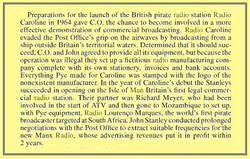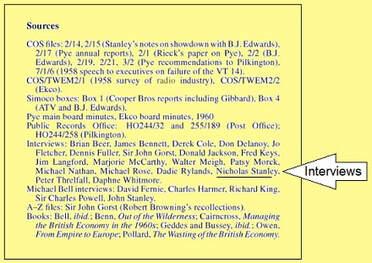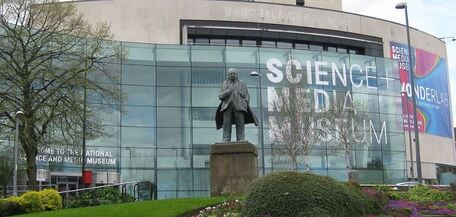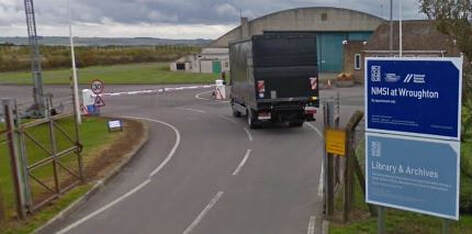|
Prince Charles explains 'pebble theatre'.
|
PEBBLE
|
|
Don Pierson [right] explains how a young Prince Charles made a request to join the Radio London fan club. |
|
|
Prince Charles explains 'pebble theatre'.
|
PEBBLE
|
|
Don Pierson [right] explains how a young Prince Charles made a request to join the Radio London fan club. |
|
|
Knowing how eager my critics are to undermine my words in order to preserve their own hoax and fraudulent schemes to attract money for a cause that does not exist, I need to insert yet another caveat: When I introduce information that you may not already be familiar with, please, don't try to reconcile it with what you have learned from false information elsewhere, because you will end up becoming even more confused than you were! I am creating a totally new and different timeline. While Paul Rusling has stolen some of his information from the former 'Caroline Investigation' newsletter, he has tried to hammer it as though it was a square peg into his round hole that leads to a void of understanding. Foolishly he has tried to brag that 'The Trio' have it all wrong because 'Jimmy Ross' did exist, and this mythological character was the primary source of funding for Radio Caroline. But 'Jimmy Ross' does not and never has existed. As best we can determine, that myth did not even begin to surface until years after the final demise of Radio Caroline. We know who began that silly story and why that person began that fable, and in due course this too will be explained. The real timeline is one that begins way, way back in the Nineteen Thirties, but not in the way that you might imagine, or try to second guess. However, the timeline of the investigation that 'The Trio' began to follow really did not start until October 25, 2014, because that is when the "lecture that never was" about the advent of Radio Caroline in 1964 was due to be delivered at the Communications Museum in Burntisland, Fife. Instead of a lecture, the assembled audience heard an embarrassing apology.  As I previously explained on March 27 (and revised, expanded and corrected on dates following) as a part of this continuing blog, the problem for 'The Trio' began with a book. It was not even a new book but one that was published in 2002, and it was only one paragraph (see left) on one page (276), in a book of 356 pages that caused a problem.  According to that text, the Stanleys (both father and son) agreed to "provide all its equipment" by setting up "a fictitious radio manufacturing company" and that "everything Pye made for Caroline was stamped with the logo of the nonexistent manufacturer." The key words being "fictitious"; "manufacturing"; "made" and "nonexistent manufacturer." Those words presented a big problem because the broadcasting equipment loaded on board the mv Caroline (ex-Fredericia), did not include any major materials that were made by any of the Pye Group of companies, and neither was there any equipment on board that bore a strange (obscure) logo or badge. The equipment came from well-known American companies. After purchasing a copy of this book In 2014, and after reading page 276, the question arose: What is the source of this information? On page 295 the sources are detailed for the preceding chapter on page 276, and this is what is listed:  No specific source is listed for page 276 about the information regarding Radio Caroline. In the back of the book there is also a listing for the box files [COS] relating to Charles Orr Stanley, but the listed contents are very general. There are additional sources listed, but nothing that specifically relates to page 276 and that paragraph. At the very top of the first page of 'Source Materials' (in the back of the book), is this added information: "The letters, documents and other material on which this book is based are held at the National Museum of Photography, Film and Television, Bradford." It was to Bradford that 'The Trio' then turned, and after many phone calls and emails they reached a brick wall of indifference.  Overtures were then made personally in both emails and phone calls to Nicholas Stanley; son of John Stanley and grandson of Charles Orr Stanley. From him it was learned that after Philips bought out Pye in the Sixties, someone gave the order to demolish a number of old Victorian houses in Cambridge which contained the Pye archives. Not only did the buildings disappear, but so did a lot of archive material. Nicholas Stanley explained (to 'The Trio') that he had established the Stanley Foundation Ltd in order to create another repository from family sources, upon which the book 'Radio Man' was then based. But unfortunately he no longer had access to those 'new' archives because they had been donated to the Museum at Bradford, along with all of the notes pertaining to the creation of the book. So 'The Trio' turned once again to the senior management at Bradford who then volunteered that all of this 'new' archive material dating back to 2002, and all of the research conducted for 'Radio Man', was not only unsorted and undocumented, but it was in a warehouse and not readily accessible.  However, there was a further complication in that the Museum at Bradford could only permit inspection of this material at their undeveloped (at that time) new storage facility which is located at the old RAF airfield at Wroughton, near Reading. But non-Museum personnel could only inspect those contents one day a month, after the Museum at Bradford also dispatched a minder to Wroughton with the requested boxes. Since there were around 48 of these bankers boxes with unsorted contents and only a general description of the contents of each box, it would be necessary for 'The Trio' or their associate to identify which box they wanted to inspect. Therefore a decision was made to contact Nicholas Stanley again, since the Foundation that he has established had hired the author and an assistant technical expert to write the book, and he had also gained support of the prestigious IEE to publish 'Radio Man'. A question was then put to him as to whether he knew the source of the information that appeared on page 276. He said that he thought that it had come from an engineer but he could recall any details since he was not the originator of the information. At some point in time an investigation was also undertaken by 'The Trio' to see what the Stanley Foundation is and what its relationship had been to the book. This composite illustration reveals some very interesting details: There seemed to be no alternative but to push ahead and ask Bradford for permission to see inside box after box in order to discover whether the source of the information that appears on page 276 and in that single paragraph, could be found within the contents. of those boxes. 'The Trio' were working with a hands-on person who had a very long history of documenting everything to do with the Caroline ships; but even he was not sure what kind of document it was that they were all looking for.
(Even getting to the old airfield which was just outside of Wroughton involved expense in both time and money. Given that there were 48 bankers boxes and that a Museum 'minder' had to be dispatched, there was also the problem of securing open-ended cooperation from the Museum management since it was impossible to say in which box, or even if any box actually contained the answer; or what kind of a document was being sought.) Tomorrow I will tell you what was discovered, and what that discovery implied regarding this research project into the origins of Radio Caroline. [Additional copy editing performed post-publication in order to tidy-up my written text.]
0 Comments
Your comment will be posted after it is approved.
Leave a Reply. |
Our team produced this free radio program for PCRL in Birmingham.
It was repeatedly broadcast on and after October 20, 1985. Click & listen! Blog Archive
August 2023
Copyright 2021 with all rights reserved.
|
Index |
Library |
|
